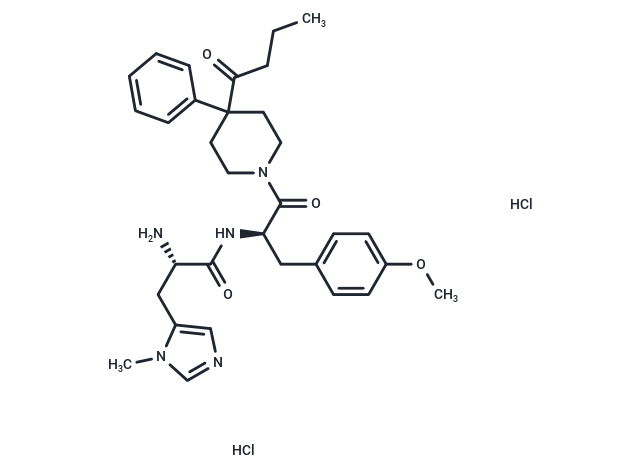Shopping Cart
- Remove All
 Your shopping cart is currently empty
Your shopping cart is currently empty


| Pack Size | Price | Availability | Quantity |
|---|---|---|---|
| 1 mg | $52 | 6-8 weeks | |
| 5 mg | $123 | 6-8 weeks | |
| 10 mg | $198 | 6-8 weeks | |
| 25 mg | $455 | 6-8 weeks | |
| 50 mg | $745 | 6-8 weeks | |
| 100 mg | $1,180 | 6-8 weeks |
| Description | BMS-470539 dihydrochloride is a selective and highly potent melanocortin 1 receptor (MC-1 R) agonist with anti-inflammatory activity. BMS-470539 attenuates oxidative stress and neuronal apoptosis via the MC1R/cAMP/PKA/Nurr1 signaling pathway in a neonatal hypoxia-ischemia rat model. |
| Targets&IC50 | MC1R:120 nM, MC1R:28 nM (EC50) |
| In vitro | METHODS: BMS-470539 dihydrochloride (0-1μM, 15 minutes) was used to treat HBL cells stably transfected with NF-B luciferase reporter gene, and then treated with 0.5 ng/mL TNF-α for 4 hours to study its effect on stable transfection. Effects of NF-B luciferase reporter gene on TNF-α-stimulated luciferase activation in HBL cells. RESULTS:BMS-470539 dihydrochloride treatment of HBL cells with NF-B luciferase reporter gene caused a dose-dependent significant reduction in TNF-α-stimulated NF-B luciferase activity. [2] |
| In vivo | METHODS: BMS-470539 dihydrochloride (2.05-18.47 mg/kg, intravenous injection, 125 minutes) was used to treat WT and MC1 receptor-negative e/e mice to study its effects on mesenteric microcirculation. RESULTS:BMS-470539 dihydrochloride treatment of mice inhibited cell adhesion and migration, had no effect on cell rolling, and also inhibited the tissue expression of two chemokines, CXCL1 and CCL2. [3] |
| Alias | BMS470539 dihydrochloride, BMS 470539 dihydrochloride |
| Molecular Weight | 632.62 |
| Formula | C32H43Cl2N5O4 |
| Cas No. | 2341796-82-3 |
| Storage | store at low temperature,keep away from moisture | Powder: -20°C for 3 years | In solvent: -80°C for 1 year | Shipping with blue ice. |

Copyright © 2015-2024 TargetMol Chemicals Inc. All Rights Reserved.